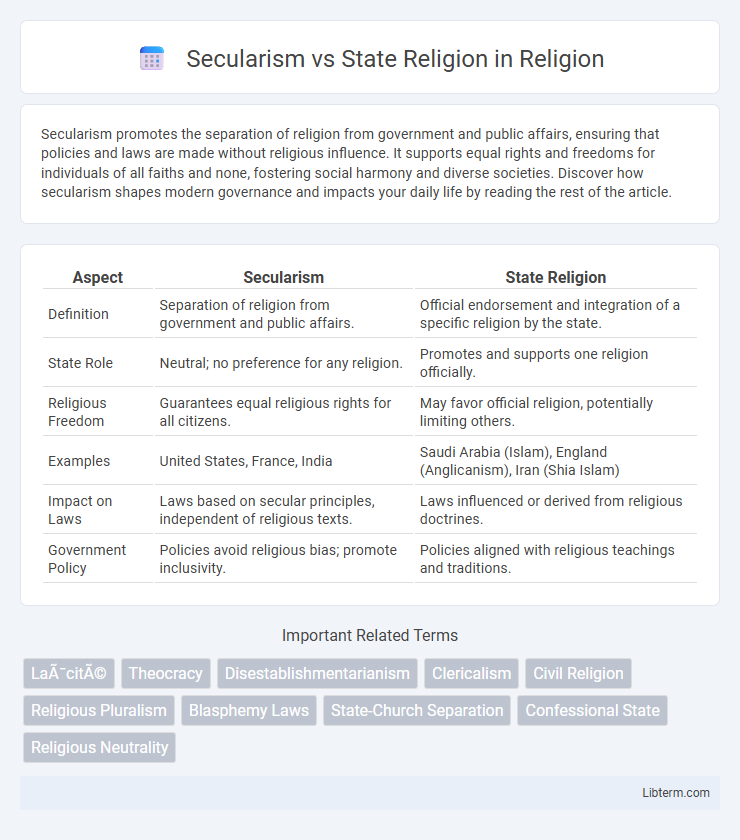Secularism promotes the separation of religion from government and public affairs, ensuring that policies and laws are made without religious influence. It supports equal rights and freedoms for individuals of all faiths and none, fostering social harmony and diverse societies. Discover how secularism shapes modern governance and impacts your daily life by reading the rest of the article.
Table of Comparison
| Aspect | Secularism | State Religion |
|---|---|---|
| Definition | Separation of religion from government and public affairs. | Official endorsement and integration of a specific religion by the state. |
| State Role | Neutral; no preference for any religion. | Promotes and supports one religion officially. |
| Religious Freedom | Guarantees equal religious rights for all citizens. | May favor official religion, potentially limiting others. |
| Examples | United States, France, India | Saudi Arabia (Islam), England (Anglicanism), Iran (Shia Islam) |
| Impact on Laws | Laws based on secular principles, independent of religious texts. | Laws influenced or derived from religious doctrines. |
| Government Policy | Policies avoid religious bias; promote inclusivity. | Policies aligned with religious teachings and traditions. |
Understanding Secularism: Definition and Principles
Secularism is a political and social philosophy that advocates for the separation of religion from governmental institutions, ensuring that public policies and laws remain neutral with respect to religious beliefs. It emphasizes principles such as freedom of religion, equality before the law, and the prevention of religious influence over state affairs to safeguard individual rights and pluralism. Understanding secularism involves recognizing its role in promoting a neutral public sphere where diverse religious and non-religious communities coexist without state endorsement or discrimination.
What is a State Religion? Key Concepts Explained
A state religion, also known as an official religion, is a religious body or creed officially endorsed and supported by the government of a country, often influencing laws and public policies. Key concepts include government funding, religious symbolism in state functions, and preferential treatment of the religion over others, potentially limiting religious pluralism. This contrasts with secularism, where the state maintains neutrality in religious matters, ensuring equal treatment for all faiths and non-religious beliefs.
Historical Context: The Evolution of Secular and Religious States
The evolution of secular and religious states traces back to ancient civilizations where religion often intertwined with governance, exemplified by the theocracies of Mesopotamia and Egypt. The Enlightenment era marked a significant shift, promoting secularism through the separation of church and state in Western political thought, influenced by philosophers like John Locke and Voltaire. Modern secular states, such as France with its laicite policy, contrast starkly with contemporary religious states like Iran, where Sharia law forms the basis of legal and political systems.
Secularism in Modern Governance: Global Examples
Secularism in modern governance promotes the separation of religion from state affairs, ensuring equal treatment of all citizens regardless of faith. Countries like France, India, and the United States exemplify secular frameworks where laws and policies are designed to prevent religious influence on government functions. This approach fosters pluralism, protects individual freedoms, and maintains neutrality in diverse societies.
State Religion Systems: Prevalence and Variations Worldwide
State religion systems are prevalent in approximately 25 countries, where government authority explicitly endorses and supports a specific faith, influencing legislation and public policy. Variations include established churches like the Church of England, Islam as state religion in Middle Eastern countries such as Saudi Arabia, and forms where religious law partially governs state affairs, exemplified by some Islamic republics. These systems often intertwine religious principles with national identity and governance, impacting religious freedom and minority rights worldwide.
Political Implications: Balancing Faith and State
Secularism ensures the separation of religion from government, promoting equal rights and preventing religious bias in laws and policies. State religion systems can centralize power by aligning political authority with a specific faith, potentially marginalizing minority groups and affecting social cohesion. Balancing faith and state requires nuanced governance that respects religious diversity while maintaining impartial political institutions to safeguard democratic principles and human rights.
Social Impact: Inclusivity vs. Religious Identity
Secularism promotes inclusivity by ensuring equal treatment of all individuals regardless of religious affiliation, fostering social cohesion in diverse societies. State religions often reinforce a particular religious identity, which can marginalize minority groups and limit social integration. The balance between secularism and state religion significantly influences national unity and the protection of religious freedoms.
Legal Frameworks: Constitutions, Laws, and Religious Freedom
Legal frameworks surrounding secularism and state religion vary significantly, with some constitutions explicitly endorsing secularism to ensure the separation of religion and government, while others declare an official state religion, shaping national laws accordingly. Constitutions that uphold secularism typically embed provisions protecting religious freedom, preventing religious interference in legislative processes and guaranteeing equal rights regardless of faith. In contrast, states with an official religion may implement laws favoring that religion, which can lead to restrictions on religious minorities and complicate the application of unbiased legal principles.
Secularism vs. State Religion: Challenges and Controversies
Secularism faces significant challenges and controversies due to its principle of separating religion from state affairs, which often conflicts with countries that uphold a state religion. The tension arises in policy-making, legal interpretations, and social cohesion, where secular laws may clash with religious doctrines and influence on governance. Controversies include debates over religious symbols in public spaces, religious education, and the extent of religious freedom, highlighting the complex balance between respecting diverse beliefs and maintaining secular governance.
Future Trends: The Changing Relationship Between Religion and State
Future trends indicate an evolving relationship between secularism and state religion as governments increasingly navigate religious pluralism and societal demands for inclusive governance. Emerging models emphasize balancing religious freedom with secular policies, reflecting diverse populations and global interconnectedness. The rise of digital platforms also amplifies debates on religion's role in public policy, shaping state approaches toward both secular and religious frameworks.
Secularism Infographic

 libterm.com
libterm.com